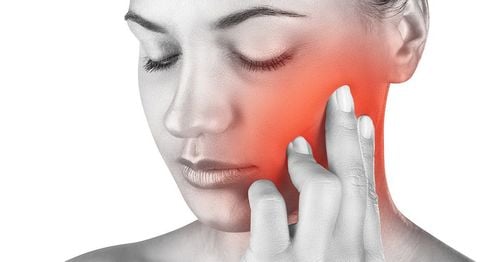This is an automatically translated article.
The article is professionally consulted by Master, Doctor Huynh An Thien - Department of Medical Examination & Internal Medicine - Vinmec Danang International General Hospital.
Trigeminal neuralgia is a rare disease, due to damage to the sensory nerve fibers of the nerve, when there is a stimulus, it will form a pain conflict.
1. What is trigeminal neuralgia?
The trigeminal nerve (or trigeminal nerve) is the V cranial nerve, one of the main nerves of the facial region. Branches of the trigeminal nerve transmit touch and pain sensations in the face, teeth, and around the mouth to the brain. In addition, the trigeminal nerve also controls the muscles for chewing and regulates the production of tears and saliva.Nerve pain is pain caused by nerves. Trigeminal neuralgia causes sudden pain in one or more branches, manifesting in the areas where they transmit sensation. The pain is usually severe in the second (V2) and third (V3) branches, often occurring around the cheek or jaw area or both. Pain on the forehead and around the eyes is less common. Trigeminal neuralgia is uncommon in cases of pain on both sides of the face, usually affecting only one side of the face.
In trigeminal neuralgia, the patient will feel like a needle, being punctured by a sharp instrument such as a knife. The pain usually goes away after a few seconds but can last up to two minutes, with an interval of several minutes, hours or even days. However, some pain may repeat in a row.
Trigeminal neuralgia can be so sudden and severe that it causes jerks. The patient has a dull ache and tenderness in the affected areas. This usually subsides for a short time. If a patient has constant pain in the face, it is usually not due to trigeminal neuralgia.

2. Causes of trigeminal neuralgia
Trigeminal neuralgia is mainly caused by a blood vessel compressing at the base of the nerve where they travel from the brain out of the skull. However, it is not known why as we age, blood vessels begin to compress the trigeminal nerve.Trigeminal neuralgia may be a symptom of other conditions, such as a brain tumor, multiple sclerosis, or abnormalities of the skull base. These diseases are accompanied by facial pain symptoms such as neuralgia X, postherpetic neuralgia, Sluder's syndrome, Reader's syndrome, temporomandibular joint pain, cluster headache, posterior facial neuralgia. trauma, neuralgia of the knee, pain due to disease of the teeth, eye sockets or sinuses. In some cases the cause is unknown.
Trigeminal neuralgia is uncommon, occurs mainly in adults, the elderly and is usually between the ages of 60 and 70. Females experience this condition more often than males.
3. Complications of trigeminal neuralgia
Trigeminal neuralgia can lead to complications. If left untreated, patients can become depressed or anxious. Patients will not dare to eat or brush their teeth for fear of causing pain, leading to weight loss, malnutrition and poor oral hygiene. However, most cases are caused by pressure from blood vessels, so there are no complications affecting the trigeminal nerve or the brain.In rare cases, trigeminal neuralgia occurs due to other conditions where other symptoms of this disease appear later. Trigeminal neuralgia may present with muscle paralysis, loss of balance, or decreased vision in multiple sclerosis.
4. Treatment for Trigeminal neuralgia

Patients are only treated surgically when the drug treatment is not effective. Commonly applied methods are alcohol injection into the 5th nerve branch, thermocoagulation, radiofrequency ablation or Gasser ganglion irradiation, and selective nerve excision after the Gasser ganglion.
In summary, trigeminal neuralgia is very rare, but if it is acquired, it will make the patient uncomfortable and painful in daily activities such as eating, brushing teeth,...
Some pathologies Others can also cause symptoms of facial pain, headache, easily confused with idiopathic trigeminal neuralgia and need to be diagnosed with exclusion such as: rhinosinusitis, hortonal headache, brain tumor... Therefore In order for the diagnosis and treatment to be accurate, patients should go to the doctor soon when there are abnormal signs and examine them in hospitals with specialists in neurology, otolaryngology, and maxillofacial.
Please dial HOTLINE for more information or register for an appointment HERE. Download MyVinmec app to make appointments faster and to manage your bookings easily.














